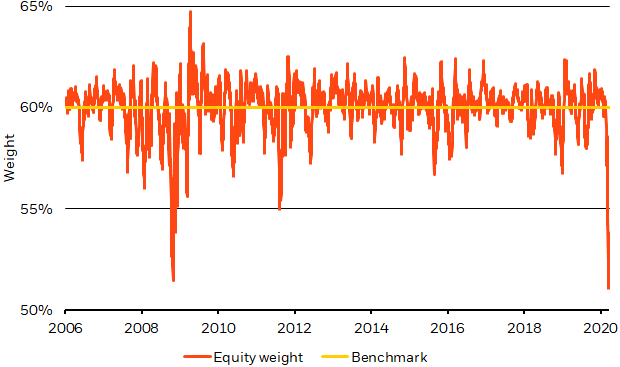We are in uncharted waters. No one knows for certain how long this crisis will last, or what the economic impact will be. But we know that this too will pass, just as other crises throughout history have.
That’s why the most important thing to do is not panic when markets fall, and temper exuberance when they rise. The swings of the markets can exhaust even the most experienced market participants. Perhaps it makes sense to practice some “social distancing” from your portfolio by tuning out the daily ups and downs of the market.
Investors should instead focus on the long term. We believe that a diversified asset allocation is a critical factor in meeting long-term goals, rather than market timing. After all, it is extraordinarily difficult to time the market, to try to sell at the top and buy at the bottom. Historically, the S&P 500 index has returned an average of 22% in the six months after a selloff going back to 1962, and 46% two years later (Source: Bloomberg, as of March 16, 2020). As painful as it may be, if you have a well-diversified portfolio, it’s important to stay the course.
Still, every investor is different. Goals, risk tolerance and the current state of an investor’s portfolio all matter. And while I’m not suggesting we’ve reached a bottom, from a long-term perspective, investors should continue to monitor their asset allocation and consider rebalancing back to strategic weights or to capitalize on opportunities the current turmoil presents.
After all, a traditional 60/40 portfolio (in other words, consisting of 60% equities and 40% bonds, which is often used as a representative allocation for long term investing), would now be a 51/49 portfolio. That could mean your portfolio is not aligned with the risk you are willing to take to achieve your goals. The last time markets experienced this kind of volatility – during the 2008/2009 financial crisis – investors who rebalanced back to their target asset allocation every time their portfolio moved more than 5% from its target outperformed by 1.77% those who didn’t. Even so, those who stayed invested through the crisis were still far better off than those who missed out on the rebound. Again, this is not about trying to time the bottom, but simply staying on track to meet your goals.
Chart of the week
One-month drift from equity benchmarks in a 60/40 portfolio, 2006-2020

Past performance is not a reliable indicator of current or future results. It is not possible to invest directly in an index. Source: BlackRock Investment Institute, with data from Refinitiv Datastream, March 2020. Notes: The chart shows the rolling one-month move away from the benchmark weight of equities in a hypothetical 60/40 portfolio of 60% equities and 40$ bonds. We use the MSCI World Index and Bloomberg Barclays Global Aggregate Bond Index to represent the two asset classes.
Against that backdrop, over the last few weeks, I’ve spoken with a broad number of institutions, financial advisors and other investors about how they are addressing this turmoil. Here are five ideas they are pursuing to help bolster a portfolio and make it potentially more resilient, all accessible with ETFs:
Keeping the core: The core of a portfolio is the foundation, which typically consists of a blend of stocks and bonds appropriate for the investor’s goals and risk appetite. The velocity of recent market declines means that now may be a good time for investors with a long-term horizon to add to a broadly diversified equity portfolio through exposure to U.S. stocks and other core exposures for a portfolio. As noted above, this may mean adjusting one’s portfolio to return to a target strategic asset allocation, most likely by “re-risking” into equities, and reducing fixed income.
Learn more about the iShares Core ETFs.
Focusing on quality exposures: We are likely to be entering a recession, although no one knows what its length or severity might be. If that’s the case, it makes sense to own higher quality companies with strong cash flows, stable earnings and low debt levels. These are the types of companies that historically have provided some measure of resilience in a portfolio.
Learn more about the iShares Quality factor ETF.
Learn more about iShares Quality Dividend ETFs.
Minimizing volatility: Given the unprecedented upheaval we’ve seen in the markets, some investors are wanting to try to mitigate volatility while keeping exposure to stocks. Investors have embraced strategies designed to reduce overall equity market risk in recent years, so-called minimum volatility strategies. In fact, these were among the fastest growing ETFs in 2019.
Learn more about iShares Minimum Volatility ETFs.
Embracing environmental, social and governance (ESG) strategies: We believe high-ESG rated companies may perform better in a post-Coronavirus environment and add resilience to a portfolio. These companies tend to have quality attributes: strong balance sheets, stable businesses and a strong corporate governance. They typically treat their employees well, so can recruit and retain the best talent, and use resources efficiently.
Learn more about iShares ESG ETFs.
A final note: When investing for the long term, selecting the right investment vehicle is critical. Throughout these tumultuous times, iShares exchange traded funds have proven to be indispensable, a go-to investment vehicle for investors. They can be effective building blocks for investors’ portfolios, providing transparency, efficiency and quality. Their resilience has been apparent in recent weeks, but their value over the long term is key.

